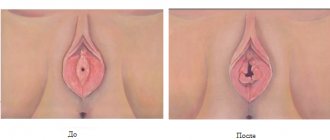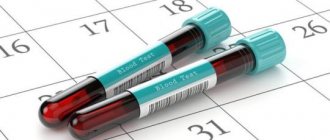Physiology of the menstrual cycle, what is menstruation?
The menstrual cycle is a regular, very complex physiological process that repeats once every 21-30 days (but most often it is 28 days). The menstrual cycle manifests itself as, in fact, menstruation (blood discharge from the uterus). Menstruation usually starts at the age of 11-15 years and ends already during menopause around 45-55 years. Also, there are no periods during pregnancy and lactation.
The menstrual cycle is regulated by complex processes that originate in our brain, where special substances are produced. These substances affect the entire female body!!!, but most of all the ovaries and uterus. A follicle matures in the ovaries, containing an egg, which after some time enters the abdominal cavity, and then into the fallopian tube - this is ovulation. If a woman’s menstrual cycle lasts 28 days, then ovulation will occur on days 13-15 from the beginning of the cycle. During the menstrual cycle, the uterus also prepares for conception under the influence of hormones: the walls thicken, and a special layer of the endometrium begins to grow. If there is no conception, then the female body gets rid of “options” that it no longer needs, such as the endometrium through menstruation. Menstruation itself (blood discharge) lasts from 3 to 7 days. Before menstruation, women may experience increased heart rate, increased blood pressure, and irritability.
The menstrual cycle can change or be disrupted due to nervous overload and stress, illness (even the simplest colds), excessively strict diets or, conversely, overeating. Menstrual irregularities do not always mean the absence of menstruation. There may also be very heavy discharge, there may be scanty discharge or a change in the duration of the cycle.
Types of violations
Irregularities in the menstrual cycle, namely its duration, may be normal or indicate more serious pathologies. Consultation with a gynecologist is especially necessary if disturbances are observed for 2–3 cycles in a row. The true cause of delayed or, conversely, premature menstruation can only be determined by a specialist. In this case, the patient’s complaints, observations, examination results and immediate tests after the examination must be taken into account.
In addition to the untimely onset of bleeding, a cycle disorder is considered to be an altered duration of the discharge itself: less than three days or more than a week. The reason for visiting a doctor is also the absence of ovulation and an uncharacteristic change in the abundance of discharge: less than 40 ml or more than 80 ml for the entire period of menstruation.
- Among the most common causes of irregular periods, it is worth highlighting:
- Gynecological and endocrine diseases.
- Disturbances in hormonal balance in the body.
- Changes in the functioning of the reproductive system during pregnancy or lactation (breastfeeding), as well as after an abortion.
- Disturbances in the production of hormones due to stress, taking medications, sudden weight gain or weight loss.
A more dangerous reason for the absence of timely periods may be the excessively prolonged presence of the corpus luteum, provided that pregnancy has not occurred. The anomaly itself can be determined only after a thorough ultrasound examination of the pelvic organs. On the other hand, it is not uncommon to encounter situations where pregnancy has occurred, but the corpus luteum, which should provide nutrition to the embryo for its further development, is not observed. In such cases, it is customary to talk about the threat of miscarriage. In this case, hormonal treatment is prescribed in order to maintain the pregnancy itself.
Reasons for shortening
A shortening of the period between menstruation may be caused by earlier development of the follicle and the release of a mature egg (ovulation), as well as earlier death of the corpus luteum at the site of the egg itself.
Among the external reasons for the onset of menstruation too early, it is worth highlighting serious diseases of the body, the occurrence of various stressful and extreme situations in which the normal course of pregnancy and the birth of a healthy child is impossible.
Table
| Violation | What it is |
| Amenorrhea | Absence of menstruation for 3 or more months |
| Dysmenorrhea | Irregularity of menstruation |
| Hypermenorrhea | Heavy periods, but they last a normal number of days |
| Polymenorrhea | Frequent periods (the interval is less than 20-25 days), or they last more than a week |
| Metrorrhagia | Uterine bleeding. Can happen any day |
| Algomenorrhea | Painful critical days |
Causes
There can be a huge number of reasons for changes in the cycle, but the most common are:
- fibroids;
- polyps;
- endometriosis;
- hormonal disbalance;
- inflammation in the pelvic area;
- diseases that are sexually transmitted.
There is no need to panic ahead of time. The cycle can be disrupted due to a sharp loss or gain of weight, frequent stress, or moving. With vitamin deficiency, various kinds of problems can also be observed. Taking medications, especially antibiotics and hormonal medications, quite often affects women's health.
Violation of the interval between menstruation may be a sign of other diseases, as a result of which you should not self-medicate.
How to keep a monthly calendar and fill out forms correctly
It would seem how such a small attribute can affect a woman’s future well-being. But, as we see, it can. Many gynecological procedures can be avoided precisely because the woman consults the doctor on time, providing him with a calendar. After all, in order to correctly calculate the duration of the cycle, the patient needs to know when the next menstruation will begin. Gynecologists recommend marking even the initial, slightly visible discharge on the calendar. The average length of the menstrual cycle is twenty-eight days. And of course, this is an approximate figure, because everything depends on the individual characteristics of the woman. But it also happens that the number of days increases or, on the contrary, decreases, which is not the norm. Therefore, a woman should keep a calendar so that the doctor has a complete picture of the possible problems that led to the violation. Of course, it’s good when a girl knows how to keep such a calendar and regularly marks the beginning of menstruation. In order for a woman to calculate her calendar, she will need a small calendar that can even be put in her wallet. In it, a woman marks the beginning and end of her menstrual cycle. Here you also need to note a certain discomfort that the girl experiences during the cycle. A program has even been written in which you can mark your cycle, and even download this program to any electronic medium. Some calendars can even calculate a woman's next period. It is also advisable to include information about how much blood the woman lost. The norm is fifty milliliters. Sometimes it’s not very convenient to measure the quantity, so it’s enough to simply write: heavy, moderate and scanty periods. But, when there is at least one violation of the menstruation schedule, then you need to react quickly and immediately consult a doctor. Because this can serve as the beginning of possible diseases. And here, a calendar that will be able to give answers to many questions to a professional gynecologist will come in handy. Thus, the menstrual cycle calendar is an integral element of a healthy and responsible woman, which can indicate and help the gynecologist, if necessary. Be vigilant and attentive to your health, and never neglect it. Keep your calendar carefully, and it will never get lost in your wallet.
Preventive measures
To reduce the likelihood of developing various gynecological problems, you need to:
- Take a more correct attitude towards your well-being during menstruation.
- Keep a monthly calendar. Nowadays, there are special applications, programs for the phone that can be downloaded for free, so this can easily help you count and monitor your menstrual cycle.
- It is normal to visit a gynecologist 1-2 times a year.
- If symptoms of gynecological diseases appear, consult a doctor for treatment or restoration of the cycle.
How to calculate your menstrual cycle?
There are several methods that are equally successful in determining the days of the cycle.
- The first way to calculate a cycle is to perform this procedure manually. The only thing is that for this, for at least six months, a woman must monitor her health, carefully note the nature, duration and various other features. Then, she will need to select from this period the shortest in duration and the longest menstrual cycle. The number of days must be counted from the first day of the start of menstruation, and until the next menstrual cycle, namely until the first day of spotting. After this, eighteen and ten days must be subtracted from these two numbers. The first number speaks of safe days at the beginning of the month, and the second number speaks of the same favorable days, but at the end of the month. Well, the time between these numbers suggests that conceiving a child will be quite simple and easy, and the probability of fertilization is the highest.
- Also, by measuring basal temperature, it is possible to determine the menstrual cycle. Gynecologists consider it the most accurate method for determining and calculating the cycle. So, you need to measure your temperature throughout the month. But you need to remember that at the beginning of menstruation it is thirty-seven degrees. But after a couple of days it drops to normal. But then, after one or two days it rises again, and now it is more than thirty-seven degrees. This temperature stabilizes for the entire period of menstruation. Therefore, if no increase in temperature was observed, then the days are safe and fertilization cannot occur.
- And, for those who cannot imagine living without the Internet, and are heavily dependent on a variety of gadgets, they are offered a calculator option that does not need to be downloaded. This monthly calendar calculator is convenient because it can easily calculate the onset of ovulation, safe and dangerous days of pregnancy, and determine the time of premenstrual syndrome. Gynecologists are not against such calculations and such calendar maintenance. The main thing is not to forget to bring such a calendar with you to your appointment with the gynecologist, or print out all the necessary information.
Ovulation
The ovulation stage begins approximately on the 14th day of the cycle. Its duration ranges from one to two days. The egg leaves the ovary and travels through the fallopian tube. If a sperm meets on her way, there is a high chance of conceiving a child.
Each woman’s body is individual, but there are signs by which ovulation can be determined:
- Increased sexual desire;
- Mood swings, changes in taste;
- A sharp increase in body temperature by several tenths of degrees;
- Pain in the mammary glands;
- Slight discomfort in the lower abdomen;
- During ovulation, discharge becomes most abundant.
You can use several methods to determine the days of ovulation:
- Conduct a special test, which is sold at the pharmacy. It is dipped into a container with urine. Two lines on the test indicate ovulation. The test is used daily 2 weeks before the expected date.
- Body temperature measurements over several months. At the initial stages of the cycle, the temperature is at 36.2-36.6 degrees. During ovulation it rises sharply to 36.8-37 degrees.
- Ultrasound for ovulation. The most reliable method.
What data should be shown in the calendar?
It is important to enter data into the calendar correctly and note the slightest changes.
- The beginning of menstruation, the nature of the discharge and its intensity.
- Physical exercise. Some sports (weightlifting, competitive cycling) can provoke increased bleeding and also increase the duration of discharge.
- Nutrition. During menstruation, eating foods that are too fatty, spicy, or non-specific for a natural diet can cause hot flashes, increase the intensity of bleeding, and change hormonal levels.
- Sexual acts. Throughout the entire cycle, it is necessary to regularly record intimate relationships, whether they were protected or not.
- Intermenstrual discharge, its viscosity (thickness), color, smell, intensity. As a rule, such discharge - cervical mucus - appears in the middle of the cycle before ovulation. These are the days when you are most likely to get pregnant.
- Emotional condition. As ovulation approaches (11-15 days from the first date of menstruation, if the cycle is 28 days), an increase in libido, tenderness, and joyful high spirits is observed, and in the second phase, fatigue, apathy, irritability, and tearfulness are observed. The records will help determine the date of the onset of PMS and avoid problems and misunderstandings in the family due to irritability and increased emotional background.
- Measure and chart basal body temperature data - an additional method of calculating the onset of ovulation.
A basal temperature chart helps determine whether ovulation has occurred. With an irregular cycle, as well as with long delays, it is almost impossible to detect ovulation without this schedule. And without this, it is impossible to determine the most prosperous days for conception.
It is the duty of every woman to know about it and be able to feel her body.
Every woman experiences her period differently. Some feel the same as before these days, while others do not get out of bed and take painkillers. Even if critical days do not affect a woman’s well-being and performance, the rules of behavior should still be slightly changed. This will help cope with heavy blood loss, pain, nausea, and general fatigue.
During menstruation, a woman should avoid all kinds of stressful situations. Emotional overexcitation provokes profuse discharge and deterioration of well-being.
It is important during this period to concentrate your actions on pleasant moments. This is communication with friends, watching a good movie, a favorite treat
Relaxation and actions that increase blood circulation will help ease the pain syndrome. Lying in a warm bath or with a heating pad on your stomach will have a positive effect on your overall well-being.
Drinking plenty of fluids will help cope with premenstrual syndrome. Water will help avoid fluid retention in the body and bloating.
During menstruation, you need to take care of your body hygiene. These days you should take a shower more often than usual, and the water should not be hot, but warm. Tampons and pads need to be changed frequently, otherwise pathogenic bacteria may multiply intensively.
Knowing the peculiarities of the main stages of the menstrual cycle, the anatomy of your body, and the rules of behavior during critical days will help you avoid problems with your health and well-being.
How to correctly calculate the menstrual cycle
There are several ways to calculate the monthly cycle - we calculate from notes in a notebook, do difficult calculations, measure basal temperature daily... But the simplest option, which is loved by many women and girls, is to use online calendars, which will do the calculations on their own after entering the necessary information.
How to use this useful program correctly? Step by step guide:
- Enter the first day of the monthly cycle (some calendars ask you to enter the last days of menstruation).
- Note the usual duration of critical days.
- Indicate the duration of the entire monthly cycle.
This is where part of the woman’s work ends—the calendar will continue it on its own. Next, favorable days for conceiving a baby, a conditionally safe time for sex, and the ovulation period will be automatically determined.
If for some reason the period of discharge increases or decreases, the monthly cycle becomes longer (shorter), there are any special dates that need to be marked on the calendar, you also won’t have to spend a lot of time on notes. The smart program will save all the information, tell you at the right time what to fear and how to plan future events or events in life.
According to calendar
Calculating the women's calendar using the calendar method is quite simple. To do this, the calendar marks the beginning of the arrival of menstruation and the end of menstrual flow. The days when the lady had her period are also shaded. Experts advise additionally noting the peculiarities of your well-being on each day of the cycle.
After several months of such observations, you should take the duration of the shortest cycle and subtract 18 from it. You also need to determine the longest female cycle and subtract 11 from it. The results obtained are the day of the cycle on which ovulation should occur.
This technique is suitable only for patients who have a regular cycle, although even then it will be approximate, which is important to consider when making calculations.
By BT
Basal measurements will also help determine your cycle. It is possible to determine the ovulatory period using basal indicators only after 4-6 months of regular measurements. In the morning, immediately after waking up, without getting out of bed, you should measure the temperature in the mouth, vagina or anus. Such a measurement should be carried out between 6-8 o’clock in the morning, and the thermometer should be kept in the oral cavity for at least 5 minutes.
For maximum data reliability, you should sleep at least 6 hours. Using the obtained data, a graph is drawn on which the vertical axis indicates the days of the cycle, and the horizontal axis indicates thermodynamic basal indicators. On such a graph, dots are placed every day, and at the end of the cycle they are connected.
With a visual examination, it is possible to determine regular cyclic basal changes:
- A BT of 36.3-36.8°C is considered normal, but a day before the ovulatory period it decreases slightly;
- Then again there is a sharp jump to 37-37.5°C, it is on these days that the mature egg is released, after which there is a decrease in BT levels, which remain within normal limits until the onset of the next menstruation;
- A few days before menstruation, the basal data decreases again.
Knowing these features of the cycle, you can easily determine the period of ovulation and safe days for sex using a schedule.
Feels like
If a woman closely monitors changes in her well-being, then she can calculate the ovulatory period based on her own feelings. How do they manifest themselves? In the aching painful sensations in the area above the pubis. In unusual discharge, which becomes thicker and more abundant during the ovulatory period, it acquires a yellowish tint and a snotty structure reminiscent of egg white.
Also, at the onset of ovulation, women's sexual desire increases noticeably, especially among those representatives of the fairer sex whose sex life is characterized by a lack of regularity. Also, during the release of a mature egg in women, as a rule, the sensitivity of the mammary glands increases, which also swell noticeably. Sometimes ovulation is accompanied by flatulence and minor stomach upsets.
Many women note changes in gastronomic preferences, which manifest themselves in unexpected cravings for sweets or salty foods. This symptom is usually accompanied by an aversion to perfume, even one that was previously one of the favorite scents.
According to the test
There are special test systems for determining ovulation. Outwardly, they resemble traditional test strips for detecting pregnancy, only they react not to hCG, but to luteinizing hormone, the amount of which changes sharply the day before ovulation. With such changes, a second line appears on the test.
By ultrasound
Ultrasound diagnostics is considered the most accurate method for determining the ovulatory period, but calculation will require 3-4 ultrasound scanning procedures. The first diagnosis is carried out approximately on the 5-8th day of the cycle, the subsequent ones after approximately 48 hours. The monitor will show the process of exit and advancement of the mature cell into the uterine body.
Ways to maintain a menstrual cycle calendar.
The easiest way is to have a pocket calendar and use a permanent marker (write on lamination) to mark the days.
You can simply save the picture above in the text, print it and mark it.
Another great way is to download a special application for your smartphone. There is definitely one for Android. There you are asked to enter the first and last day of the cycle, and the program will calculate everything itself. You can even make a planner showing “safe days” if you need to protect yourself, and ovulation if you want to have a baby.
Functions of a women's calendar
The women's calendar is of great importance, so every girl needs to keep it. In this case, it does not matter at all whether she is sexually active or not. Why is this so important? This is due to the functions that the menstruation calendar performs. Here are the main ones:
- Provides information about women's health. If there are problems in the reproductive or hormonal system, this will affect the regularity of the cycle. If a girl keeps a women's calendar, any disruptions in the cycle will immediately become obvious. In addition, the regularity and stability of the cycle also indicates the state of health in general. Timely detection of cycle disturbances will allow timely identification of the problem and the cause of disturbances in the body and take appropriate measures.
- Provides necessary information to the gynecologist. At an appointment with a gynecologist, the doctor always asks a question regarding the date of the last menstruation, etc. A woman must know the answers to these questions, since the result of a gynecological examination depends on this. The monthly calendar greatly facilitates this task, since it is not always possible to keep all the dates in memory.
- Allows you to avoid going to the doctor again. Most women have no idea what happens in their body at each phase of the cycle. However, if a woman keeps a monthly calendar, many questions in unclear situations will disappear by themselves, and the woman will not have to run to the gynecologist for answers. For example, on the 20th day of the cycle, a girl may notice blood stains on her underwear. Most will probably be afraid of an unusual situation. In fact, this can happen when an egg implants into the wall of the uterus. Or, for example, if a woman experiences pain in the lower abdomen or notices heavy discharge, she, based on the dates on the calendar, can understand that it’s all about ovulation, etc.
If a woman keeps a calendar, she herself can explain certain processes occurring in the body today.
Psychological aspect
In this case, we can talk about two useful functions that the women's calendar provides. We are talking about the psychological state of a woman.
For example, if a woman does not keep track of her periods, she is in constant tension waiting for the expected date of the next menstruation. Banal forgetfulness can even turn into neurosis if, in the opinion of a woman, she has a delay (although in fact she simply made a mistake with the start date of menstruation). If you calculate your menstrual cycle, you can avoid additional psychological and nervous stress.
Another point related to menstruation concerns premenstrual syndrome. This sometimes becomes a real test for those around the girl, and for herself too. If a girl starts counting her periods, this will help her:
- understand what is happening in her body;
- prepare psychologically for an unpleasant period;
- explain to those close to you what is happening and receive more loyal and tolerant feedback;
- control your mood and not take it out on loved ones.
Knowing about the onset of PMS, a girl can change her lifestyle, for example, adjust her diet in favor of lighter foods and give up chocolate, alcohol, etc.; adjust skin care to avoid hormonal acne, etc. All these activities also have a positive effect on the girl’s psychological state.
Women's calendar and pregnancy planning
Whether a woman wants to conceive a child in the near future or is categorically against having children, but for each of them it is very important to calculate the menstrual calendar. In this case, the calendar performs the following functions:
- Allows you to identify delays. Most often, women keep a women's calendar in order to detect delays in time. This is directly related to determining a possible pregnancy. Having noticed a delay, a woman can take a pregnancy test and sign up for an ultrasound. If pregnancy is confirmed, the woman can take appropriate measures depending on whether the pregnancy is desired or not. If pregnancy is not confirmed, it will be possible to identify the cause of the delay in time and eliminate it.
- Helps calculate fertile days. Every woman who is sexually active needs to know when her ovulation day occurs. Why is this so important? If a woman is planning to have a child, this information will tell her which days will be the most favorable for conceiving a baby. This information will be no less important for those girls who are not planning a pregnancy - information about fertile days and ovulation will allow them to be more careful and avoid unwanted conception.
However, every girl who does not want to get pregnant must remember that protection only on fertile days is not enough. It is also necessary to use other methods of contraception, since even on the so-called safe days it is also quite possible to become pregnant, although the chances of this are lower than during the ovulatory period.
- Allows you to determine the expected date of birth. Of course, this is usually done by a gynecologist, but if a woman regularly keeps a calendar, it will not be difficult for her to do this on her own. There are several calculation options, but the simplest is according to the Naegele formula: 3 months are subtracted from the first day of the last menstruation and 7 days are added. This will be the expected date of birth. But this formula only works if a woman’s cycle averages 28 days and is regular. If a woman’s cycle lasts longer than 28 days, then ovulation occurs later, so bearing a child also lasts a little longer. On the contrary, with a shorter cycle, the child may be born slightly earlier than the calculated date. Do not forget about other factors that also affect the duration of pregnancy.
- Allows you to plan the gender of your future baby. It is immediately worth noting that this method has not been scientifically proven. However, future parents, for whom the gender of the baby is of great importance, often use this method. As a rule, if conception occurs in the middle of the cycle, then a son is born, but if a woman becomes pregnant 1 - 2 days before the start of ovulation, then a daughter is usually born.
This is explained by the fact that sperm, carriers of the male chromosome, are more mobile and quickly move through the female reproductive tract. But future girls are characterized by less mobility, but greater endurance, so they remain viable in the genital tract for up to several days.
The role of the calendar in irregular cycles
A calendar is indispensable if a woman has an irregular cycle. For such women, the problem is to determine the day of ovulation. However, there are many computer and telephone applications that help automatically calculate the days of your period, in particular the day of ovulation.
A calendar is also indispensable where a married couple does not conceive. Usually, when planning a pregnancy for couples, everything is done within 12 months. But if spouses have sex on the wrong days, this may cause a lack of positive results. Therefore, if the desired pregnancy does not occur, do not panic and run to a consultation with a gynecologist. The problem may be precisely that the couple does not take into account the most favorable days for conception. The menstrual calendar will help you determine these days. Additionally, it is worth measuring your basal temperature daily and conducting ovulation tests. All this further increases the chances of pregnancy.
Every woman deals with menstruation once a month. This event shows how healthy a woman is, and not only from a reproductive point of view. For this reason, you need to be able to correctly maintain your personal monthly calendar.
Normal menstrual cycle
The duration of the menstrual cycle is an individual feature of each woman. Usually this period ranges from 3-5 weeks, much depends on the structure of the body, state of health, and age. That is why, when using the program, it is better not to rely on the first indicators - to correctly enter information into the calendar on a monthly basis.
If the dates coincide, and all the necessary days (ovulation, menstruation, safe or risky periods in terms of sex) are indicated accurately, you will not have to enter any more indicators. Every month the program will accurately indicate the information of interest.
If the calendar has errors of several days, there is no particular reason to worry - similar manifestations occur in every woman. Even safe factors in the form of dietary adjustments and physical work intensity can lead to failures.
Gynecologists warn that if there are no specific reasons for changing the duration of the menstrual cycle or menstruation itself, it is better to seek the help of a doctor. Only after an examination will it be possible to determine what factors provoke the failure and, if possible, eliminate them.
Why do you need a calculator?
Most women have a lot to do. Plans are often made months in advance; spontaneous occurrence of various life vicissitudes is also possible. But the body obeys its own laws, the most important of which is regular menstruation. This can confuse all plans and create new problems. But if you use a cycle calculator, it will be easy to separate vacations, weddings, and everyday activities in time with critical days. It is important to know this for sure to plan a doctor’s visit and medical procedures.
What can a menstruation calculator do?
- Period of menstruation. Knowing the exact date of critical days, you can free this time from difficult matters in advance in order to be able to relax, not burden your memory and mind with problems, and therefore protect your health. After all, during this period it is more difficult to concentrate, but sometimes it is necessary to lie down and endure painful sensations, drowsiness, and irritability.
- Volume of discharge. The calendar will tell you when menstrual flow begins to subside, so that a woman can plan what hygiene products she will need, whether she can go to the pool, wear a light skirt, or whether she should postpone her vacation.
- Days when PMS is more pronounced. As a rule, this happens before the start of menstruation. And so that you don’t have to guess why your stomach feels tight, your chest ache, everything and everyone irritates you, you want to eat the whole cake, you should know about them in advance. This will help you prepare mentally and physically for the difficult period of critical days, stock up on pills, and not plan things.
- Ovulation calendar. It is no secret to most that conception is possible only when the egg matures. If you plan to have a child, the calculator can calculate the day of ovulation in each month for the whole year. This will be useful not only for busy people, but also for those who have difficulty conceiving. The favorable days for pregnancy are shortly before and immediately after ovulation. On these dates, it is worth making every effort to achieve your goal.
Reasons for possible cycle failures
There are many factors that can provoke a failure, and the indicators of the menstrual calendar will be useless. The most common, sometimes unwanted, and sometimes the most pleasant reason is unplanned pregnancy. It’s easy to verify this - purchase a special test at the pharmacy that will confirm your suspicions.
If menstruation appears after positive indicators, it is recommended to immediately go to the gynecologist - there is a risk of unwanted and even dangerous complications for the fetus that require immediate medical intervention.
Another reason for failures in the duration of the term is regular stress. The following problems can provoke manifestations that are dangerous to health:
- frequent quarrels, scandals at home;
- conflicts at work;
- divorce;
- fatigue.
The hormonal system usually suffers, and this manifestation ends with a long or short menstrual cycle, long periods.
A sharp change in climate also often causes discomfort in women, which ends in cycle failure. Everything will pass when the body gets used to unexpected changes, but until then you should not completely rely on the indicators of the menstrual calendar.
Intense sports activities or heavy physical work can also negatively affect your periods. To achieve high accuracy from the calendar and not let the highlights take you by surprise, it is better to enter data every month. After menstruation arrives at a strictly defined time, you will not have to enter additional information.
The menstrual calendar will also show incorrect dates of discharge, ovulation, safe and dangerous days in women who have adjusted their diet or gone on a strict diet. A lack of certain vitamins or minerals will easily affect the condition of the body and menstruation. If you lose a lot of weight during the diet, the discharge may stop altogether.
Colds, accompanied by a rapid rise in temperature, severe cough, and inflammatory processes, also threaten changes in the menstrual cycle. Treatment with antibacterial drugs or aggressive drugs that negatively affect the body is especially dangerous. Calendar indicators return to normal only after restoration.
The last reason for incorrect calendar indicators is dangerous diseases of the internal genital organs. The female body is able to react negatively to inflammatory processes, ovarian diseases, erosion and even the development of cancer. In order to promptly prevent a dangerous manifestation, it is recommended not to forget about preventive examinations with a gynecologist.
Causes of irregularities in the menstrual cycle
The menstrual cycle is considered to be the duration between the first day of menstruation and the first day of the subsequent menstruation. The natural permissible value is 28 – 35 days.
Disruptions in the female cycle are characteristic of metabolic disorders, stress, a sharp decrease (increase) in body weight, as well as many gynecological diseases.
A violation can also occur for the following reasons:
- hormonal imbalance, ovarian dysfunction;
- damage by cystic formations (in polycystic ovary syndrome - PCOS), uterine fibroids;
- inflammatory processes;
- thyroid diseases;
- hyperprolactinemia;
- endometriosis;
- hyperandrogenism;
- vitamin deficiency, diabetes mellitus, strict mono-diets.
The female cycle is like a fragile vase. The slightest changes provoke delays and disruptions in the menstrual cycle. Therefore, in order to detect and avoid problems in a timely manner, each woman needs to keep her own menstrual calendar.
Types of violations
Table
| Violation | What it is |
| Amenorrhea | Absence of menstruation for 3 or more months |
| Dysmenorrhea | Irregularity of menstruation |
| Hypermenorrhea | Heavy periods, but they last a normal number of days |
| Polymenorrhea | Frequent periods (the interval is less than 20-25 days), or they last more than a week |
| Metrorrhagia | Uterine bleeding. Can happen any day |
| Algomenorrhea | Painful critical days |
Causes
There can be a huge number of reasons for changes in the cycle, but the most common are:
- fibroids;
- polyps;
- endometriosis;
- hormonal disbalance;
- inflammation in the pelvic area;
- diseases that are sexually transmitted.
https://www.youtube.com/watch?v=Qhz5PrxkYgE
Violation of the interval between menstruation may be a sign of other diseases, as a result of which you should not self-medicate.
A woman's cycle should be constant. The exception is adolescents, since their reproductive system has not yet fully formed, and women awaiting menopause. In other cases, you should visit a doctor with the issue of cycle failure.
Failure of menstruation may be the cause of pathology in the body:
- Proyomenorrhea - very frequent periods. They arrive in less than 21 days. These symptoms may indicate a pathology of the thyroid gland or adrenal glands.
- Opsomenorrhea - menstruation comes later than 35 days. This can be affected by stress, infections, and cardiovascular diseases.
- Polymenorrhea - menstruation increases in duration. The causes may be inflammatory processes in the uterus, ovaries or appendages.
- Oligomenorrhea - periods are very short in duration. Causes may include trauma, tumor diseases, or withdrawal of hormonal medications.
- Hypermenorrhea - excessive bleeding. The causes of such discharge can be caused by inflammation of the pelvic organs, cancer, anemia, and disorders in the endocrine system.
- Hypomenorrhea - very scanty periods. There may be ovarian problems or sexually transmitted infections.
Is it necessary to keep a monthly calendar if you are infertile?
When a woman is diagnosed with infertility, it is the calendar that will answer the doctor’s many questions regarding the diagnosis. After all, the doctor can easily determine the day of ovulation in this case. Therefore, when a woman takes responsibility for her health, keeps a calendar of the menstrual cycle, and also measures her basal temperature, then she can also easily calculate the day of ideal conception. Often, one of the causes of infertility is a disturbance in a woman’s hormones. A gynecologist determines this by prescribing a hormonal test. When a gynecologist studies the calendar, he pays attention to such points as:
- heavy menstruation;
- absence of next menstruation;
- severe pain during menstruation;
- And what is also important are those periods that appeared after a long delay.
Advanced level
For fans of modern technology, many different applications have been developed that can take on the function of a calendar and supplement it with new properties.
The developers offer various types of women's calendars for free download.
3.1. Clue – menstrual tracker
This is an application for IOS and Android, which is recognized as the best by the American College of Obstetricians and Gynecologists (ACOG).
It allows you to calculate the date of menstruation based on the analysis of previous data. The application also notifies you about the approach of menstruation, fertile days, and possible premenstrual syndrome.
With its help, you can mark the days when you had sex and take contraceptives on a schedule.
All data can be password protected to maintain confidentiality.
3.2. Flo app
This is a women's calendar with advanced features. With its help, you can also track the length of your cycle, find out about the approximate days of ovulation, and calculate the optimal days for conception.
This app can record your basal temperature, adding value to your phase information.
If pregnancy is delayed and occurs, the calendar switches to gestation monitoring mode. It allows you to track the weeks of your pregnancy, gives useful tips and tells interesting facts.
The application allows you to monitor your lifestyle:
- 1Weight.
- 2The amount of liquid you drink.
- 3Duration of sleep.
- 4Sexual relations.
- 5Mood.
All calendar data can also be protected with a password.
There are a lot of applications for cycle registration, but the more advanced ones have approximately the same set of functions. The differences lie in the design of the pages, which each woman can choose for herself.










